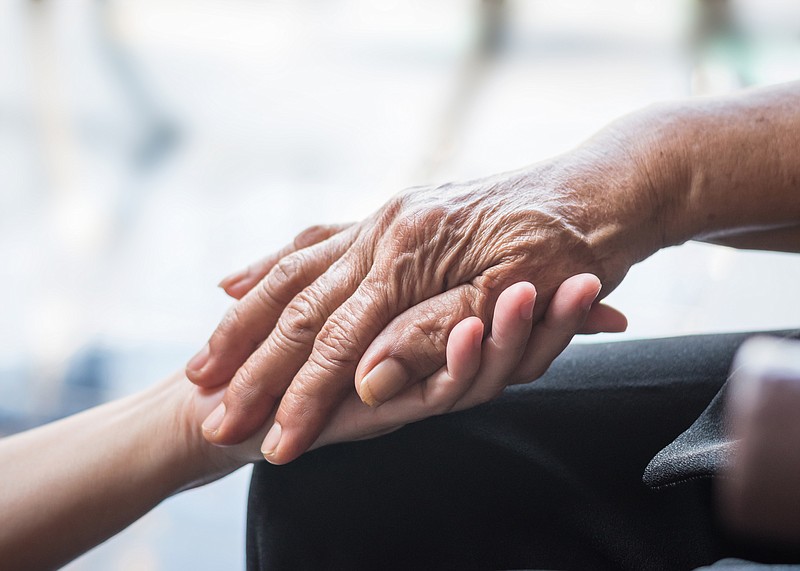Editor's note: This article is part of our series about aging and suicide. It was written with the support of a journalism fellowship from the Gerontological Society of America, Journalists Network on Generations and the Silver Century Foundation.
For decades, Jane Ellis has helped patients and families through some of their darkest times.
Ellis is a licensed clinical social worker who specializes in geriatric behavioral health at Parkridge Valley Adult and Senior Campus. There, she helps provide acute inpatient stabilization for adults experiencing mood disorders such as depression, bipolar disorder, anxiety and suicidal thoughts.
Although she admits her job is tough, Ellis is more focused on the positives.
She started her career working with children, but after about three years, she saw a job opening at another hospital's geriatric psychiatry unit.
"I took that job, and I just fell in love with it," she said.
Now, her average patient's age hovers around late 70s, but it can range up to 90s and even over 100. To her, older adults are history books with a wealth of knowledge, experience and wisdom.
"I've gleaned a lot from them," Ellis said. "Most have a really good sense of what they believe, and they're going to stick to it."
(Read more: Senior suicide: Counteracting loneliness can head off depression in older adults)
And as much as they teach her about the past, she also sees them as the future.
"We're going to have more people 65 and above who need services, so it's a great, great age group to work with," Ellis said.
Ellis recommends opening oneself up to the idea of working with seniors. She said oftentimes people who are close to their grandparents or other older adults are the ones who gravitate toward the field, but geriatrics needs more workers to meet the growing need.
"I'd like to see people even do volunteer work - put themselves in situations where they can work with older adults, like in assisted living, where there's a lot of things going on," she said.
Ellis' job is fast-paced and requires high energy. Although she has an office, she's rarely at her desk. She spends most of her day on her feet in the geriatric unit, providing individual support, group sessions, family counseling, collaborating on discharge plans and connecting people to resources, which she's a master of, according to Parkridge Valley's adult campus medical director Dr. Oliver Gregory.
"She's got decades of experience as a social worker with elderly people. She's just a wonderful resource," Gregory said, adding that she's especially good at helping families through tough transitions.
With the geriatric population, the family becomes your client, too, Ellis said.
"Many times at this level of care they're at a crossroads. Mom or dad, aunt or uncle are not doing well at home, and they need extra help," she said.
Much of her time is spent helping clients overcome barriers and finding resources, such as outpatient therapists, when not enough exist.
Many clients need increased services in their home for support, such as home health, meal assistance, or they're considering assisted living, nursing homes or memory care. Those resources become even harder to come by in surrounding rural areas, where many patients reside, or when patients need transportation or have limited funds.
"It's trying to pull a rabbit out of a hat sometimes to find somebody a resource that they need I just want there to be more resources for these people," Ellis said. "You can't give up. You've got to keep calling. You've got to keep asking. If five nursing homes turn somebody down because they had some aggression before they got here, you've got to keep calling. You've got to keep talking to people you know - say, 'Hey come out and see the patient.'"
Sometimes the biggest obstacle is the mindset surrounding mental health.
"A lot of people probably know someone who was older that may have lived with depression but would never acknowledge it. We're taught to sweep it under the rug, and it really takes a lot of joy out of life, because they can feel better. They can work through things," Ellis said.
She wishes more people learned the facts surrounding mental health and suicide from reputable sources such as NAMI, the National Alliance on Mental Illness.
"A big factor still with mental health is education. We've come a long way, but we have a long ways to go, and it's just a lack of understanding. It doesn't mean crazy," she said.
When patients are in crisis, Ellis says it's important to be present, acknowledge their difficulties and offer support to them. Once the patient is on the road to recovery, that's when their age can be a major asset.
"These people have lived a lot of years and have been through incredible, multiple life circumstances - loss of children, loss of health, loss of spouse, loss of home, everything. And they are incredibly resilient," she said. "Their perspective on life is really refreshing, and a lot of it comes down to a person's attitude about it."
Contact Elizabeth Fite at efite@timesfreepress.com or 423-757-6673.
